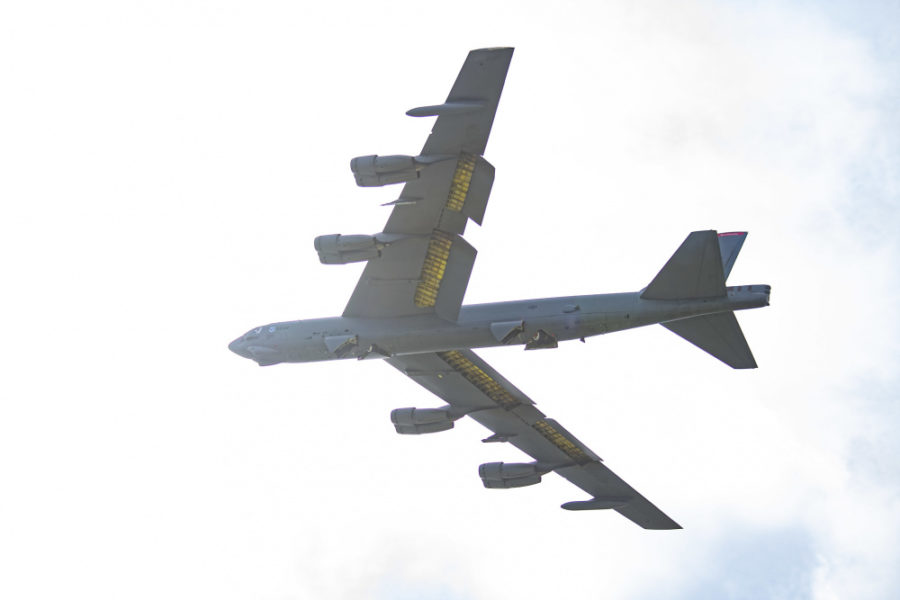The B-52H is a long-range nuclear/conventional bomber and USAF’s primary standoff cruise missile carrier. The YB-52 prototype first flew on April 15, 1952, and Strategic Air Command declared IOC with the B-52A on June 19, 1955. Boeing produced a total of 744 B-52s culminating in the last Stratofortress variant still in service, the B-52H.
Multimission capabilities include long-range precision strike, CAS, air interdiction, defense suppression, and maritime surveillance utilizing both Litening and Sniper targeting pods.
The B-52 is undergoing major upgrades to replace key obsolescent systems including engines, radar, comms, and weapons interface to extend the fleet through the 2050s.
Combat Network Communications Technology (CONECT) recently replaced cockpit displays and comms and added integrated mission-management, including Link 16, and machine-to-machine tasking/ retargeting. It forms the digital backbone of the Internal Weapons Bay Upgrade transitioning the Conventional Rotary Launchers designed for CALCM to carry the modern AGM-158B JASSM-ER. This nearly doubles the B-52’s payload of JASSM, JDAM, and MALD, while reducing drag and increasing range. CONECT also enables associated mods including Tactical Data Link to add low-latency, jam-resistant C2/comms, and GPS updates.
USAF is pursuing both the Radar Modernization Program to replace the B-52’s AN/APQ-166 with AESA and the Commercial Engine Replacement Program (CERP) to re-engine the fleet. CERP will replace the B-52’s current engines with modern, efficient and reliable Rolls-Royce F130-200 turbofans in a modified pylon-mounted eight-engine arrangement. Re-engined aircraft will be redesignated B-52J and fleetwide retrofits are expected to be completed by 2038. AESA radar is planned for introduction in 2026, and future upgrades include VLF/LF receiver modernization, ATP color MFDs to enhance targeting and situational awareness, AEHF SATCOM installation, and crypto modernization.
Integration of the future Long-Range Standoff (LRSO) nuclear cruise missile will cement the B-52’s nuclear role, complementing the B-21 Raider after retirement of the B-1 and B-2, potentially continuing to serve through the 2050s. B-52s have conducted at least nine successful LRSO test flights, culminating in a free-flight launch in October 2022.
Contractor: Boeing (airframe/CONECT); Rolls-Royce (CERP)/Collins Aerospace (nacelles); Raytheon (RMP).
First Flight: July 20, 1960 (B-52H).
Delivered: May 9, 1961-Oct. 26, 1962 (B-52H).
IOC: May 1961 (B-52H).
Production: 102 (B-52H).
Inventory: 76.
Operator: AFGSC, AFMC, AFRC.
Aircraft Location: Barksdale AFB, La.; Edwards AFB, Calif.; Minot AFB, N.D.
Active Variants: •B-52H. Longer-range development of the original B-52A, with more efficient turbofan engines. •B-52J. Future modernized B-52H, retrofitted with more efficient Rolls-Royce F130-200 turbofans.
Dimensions: Span 185 ft, length 159.3 ft, height 40.7 ft.
Weight: Max T-O 488,000 lb.
Power Plant: Eight Pratt & Whitney TF33-P-3 turbofans, each 17,000 lb thrust.
Performance: Speed 650 mph, range 8,800 miles (further with air refueling).
Ceiling: 50,000 ft.
Armament: Nuclear: 12 AGM-86B ALCMs externally, and eight ALCMs or gravity weapons internally. 12 AGM-158 JASSM externally, and eight JASSM-ER/MALD/ MALD-J internally (upgraded aircraft). Conventional: AGM-86C/D CALCMs, Mk 62 sea mines, Mk 82/84 bombs, CBU-87/89 cluster bombs, CBU-103/104/105 WCMDs, GBU-31/38 JDAMs, AGM-158A JASSMs, and GBU-10/12/28 LGBs, MALD, and MALD-J jammer variant.
Accomodation: Two pilots, navigator, radar navigator, and EWO on upward/downward ejection seats. (Radar navigator position will be eliminated on the B-52J).


